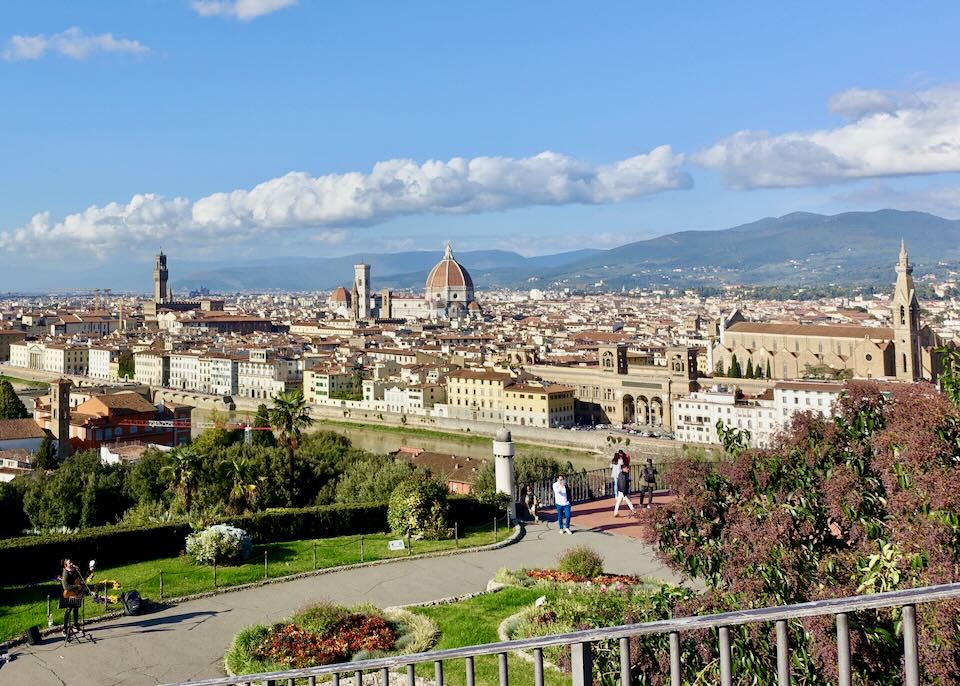
The city of Florence as seen from Piazzale Michelangelo. From left to right the three largest buildings in the skyline are the Palazzo Vecchio, the Florence Cathedral (Duomo), and Santa Croce Basilica.
Florence is one of my favorite cities in Europe. The birthplace of the Renaissance (and of gelato), it’s absolutely packed with masterpieces upon masterpieces. From the grand museums of the Uffizi, Accademia, and Bargello to the architectural wonders of the Duomo, Santa Croce, and Santa Maria Novella cathedrals, to the lavish palaces on every cobblestoned corner, Florence is a testament to Italian intellect, taste, and ingenuity. Its mild weather, walkable streets, and year-round attractions make it an ideal destination anytime, though the spring and fall months offer the best mix of good weather and smaller crowds.
The Florence Travel Guide
Skip to our Florence FAQ Florence Basics
Florence Hotels
- Best Hotels in Florence
- Best Boutique Hotels in Florence
- Best Hotels in Florence for Families
- Best Romantic, Honeymoon Hotels in Florence
- Best Budget Hotels in Florence
- Best Wheelchair Accessible Hotels in Florence
- Best Pet-Friendly Hotels in Florence
- Hotels with Private Pools & Jacuzzis in Florence
- Best Agriturismo in Tuscany
- Florence Hotel Map
Florence Activities and Attractions
- Best Things to Do in Florence
- Best Restaurants in Florence
- Best Bars in Florence
- Best Gelato in Florence
- Best Shops & Markets in Florence
Florence Day Trips
Florence Trip Planning
- Airport Transportation in Florence
- Renting a Car in Florence
- Rome to Florence by Train
- Venice to Florence by Train
- Pisa to Florence by Train
- Livorno to Florence by Train
- Greece & Italy Itinerary
The Florence Cathedral (Duomo) complex includes the cathedral, Brunelleschi’s dome, Giotto’s bell tower, and the baptistery, all seen here.
Frequently Asked Questions about Florence
Where is Florence?
Florence is located in central Italy, about 200 km southwest of Venice, 250 km southeast of Milan, 230 km northwest of Rome and Vatican City, and about 410 km northwest of Naples. The city of Florence is about 790 km east of Barcelona, Spain; 890 km south of Paris, France; and 1225 km northwest of Athens, Greece. Florence is home to roughly 708,000 people in the city and greater metropolitan area. Though the City of Florence occupies about 40 sq km, most of the city’s best hotels, sights, dining, and nightlife are located within 2 km of the highly walkable historic center.
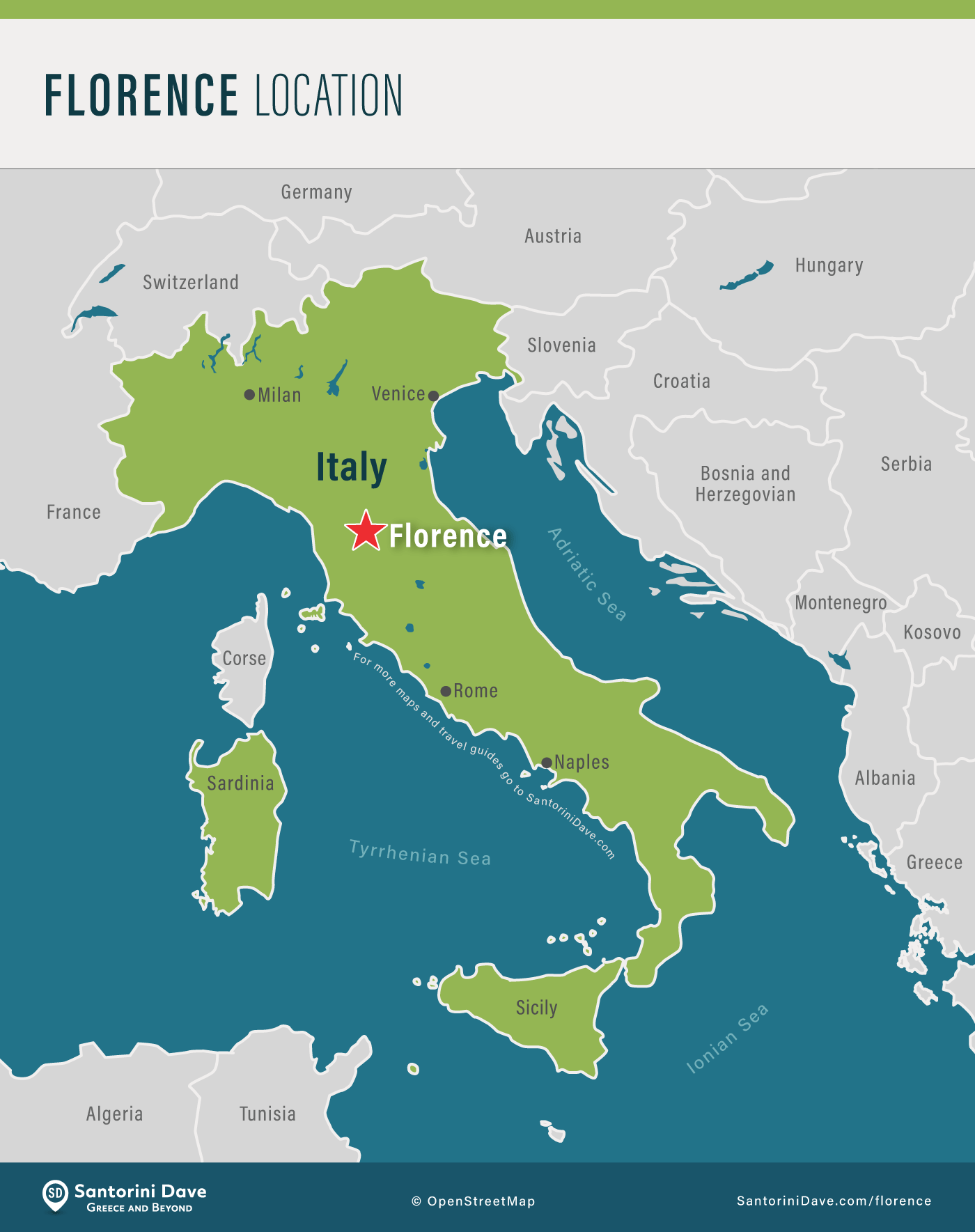
What is Florence famous for?
Florence is best known as the birthplace of the Renaissance and is brimming with museums, churches, palaces, and gardens of the era, all created by luminaries including Michelangelo, Brunelleschi, Donatello, Fra Angelico, Boticelli, Raphael, Vasari, and many more – mostly funded by the Medicis or the Church. The Uffizi Gallery is among the greatest museums in the world, boasting the largest collection of Italian Renaissance paintings, while the Bargello features the greatest collection of Italian Renaissance sculpture, and the Accademia is home to Michelangelo’s most famous work, David. Immense, ornate cathedrals stand on nearly every corner with the Duomo being the most impressive of all: topped with the world’s largest brick dome, filled with frescoes, and offering panoramic views from its bell tower. Aside from art and architecture, this compact, bustling city is also known for exceptional food (gelato was invented here), shopping at traditional artisan workshops; and Chianti wine made in the surrounding hills.
Florence’s most famous piece of art, Michelangelo’s David can be found in the Galleria dell’Accademia. There are also two replica Davids in the city, one outside the Palazzo Vecchio and one overlooking the rooftops from the Piazzale Michelangelo.
What cities have direct flights to Florence?
There are direct flights to Florence’s Amerigo Vespucci Airport (AKA Aeroporto di Firenze-Peretola) from many international cities. Flights from most cities in Western Europe (including Paris, London, Madrid, Barcelona, Vienna, Frankfurt, Amsterdam, Lisbon, Geneva, and many more) take 2 to 4 hours.
Flights from everywhere else in the world require at least one stop, usually at a major city in Europe. Flights from North American cities (including Los Angeles, Mexico City, New York, and Toronto) to Florence take from 9 to 14 hours on average. Flights from South America (such as Buenos Aires, Rio de Janeiro, or São Paolo) take between 14.5 and 17.5 hours. From the Middle East (Abu Dhabi, Cairo, Doha, Dubai, Istanbul, and Tel Aviv), flights take 6.5 to 12 hours. Flights from most major cities in Asia (including Bangkok, Beijing, New Delhi, Singapore, Taipei, and Tokyo) take from 11 to 16 hours; many flights from Asia to Florence make 2 stops.
What is the best month to go to Florence?
While Florence is a year-round destination, the absolute best times to visit the Cradle of the Renaissance is during the months of April, May, and September when the weather sunny and warm but not too hot – ideal for outdoor dining and wandering the cobblestone streets and piazzas. October is also a good bet for warm weather, but there is a slightly higher chance of rain. The winter months (November through March) bring some fog and rain, but snow is very rare – winter’s lack of sun is made up for by better rates on hotel rooms and flights. Avoid visiting in August when temperatures are stifling hot and most locals take their vacations, leaving many shops and restaurants closed or operating on reduced hours.
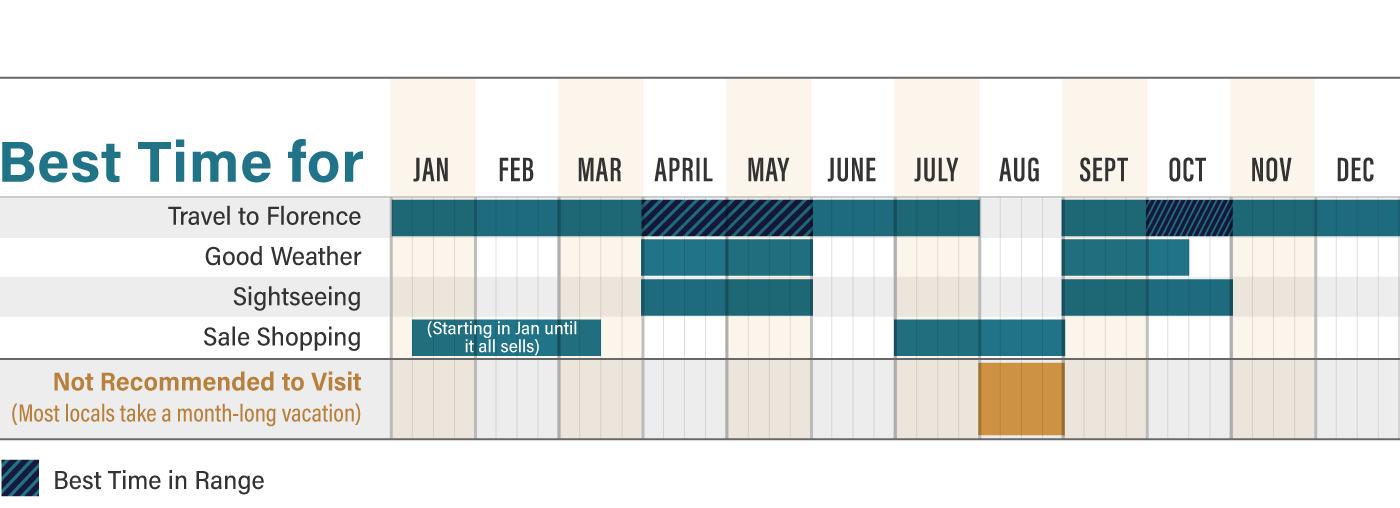
With over 400 museums, Florence is magnificent place to visit year-round and in any weather, but to explore the city’s gardens, piazzas, and outdoor attractions like the Ponte Vecchio here, it’s best to visit when it’s warm, sunny, and dry out.
How long should I spend in Florence?
The main highlights of Florence can be seen in w very full days if planned just right. Travelers who are interested in exploring the true Florence beyond the major attractions should spend at least three to 5 full days in Florence, not counting travel days. No matter how long you spend, taking a tour can be a great way to experience much of Florence’s history, art, wine, and culinary delights in a short amount of time.
Called the “Sistine Chapel of the Early Renaissance,” Cappella Brancacci is a hidden gem filled with stunning frescoes by Masaccio, the first great painter of the Renaissance. Travelers will need a minimum of 2 days to see the major sights of Florence and 3 to 5 days to discover the city’s secrets.
Is Florence safe?
Florence is a very safe city with a low crime rate. In the heart of the city, most streets are pedestrian-only, the piazzas and streets are well-lit at night, and most are filled with people milling about the restaurants, cafes, and bars until late in the evening. As in most major destinations, travelers need to be aware of pickpockets, especially in the crowded train station and tourist-filled hot spots, like the Ponte Vecchio, Piazza del Duomo, and outside Mercato Centrale. Travelers to Florence will be safe and secure so long as they take normal precautions, stay aware of their surroundings, and keep their money out of easy reach. Florence is a safe and popular destination for solo, female travelers.
A nighttime view of the Piazza della Repubblica. Most streets and piazzas in Florence are well-lit and filled with people long after it gets dark.
Where is the best area to stay in Florence?
Despite Florence’s relatively small size, the city offers several great neighborhoods, each with its own distinctive personality. The best neighborhoods to stay in Florence are the City Center (best for first-timers, near all major attractions), San Frediano and Santo Spirito (authentic feel, artisan workshops, and great nightlife), San Lorenzo and San Marco (local vibe, great for foodies), San Niccolò and Piazzale Michelangelo (most romantic with gardens, villas, and views), Santissima Annunziata (quiet area yet close to attractions), Santa Maria Novella (luxe and romantic near the river, but a little gritty near the train station), Santa Croce and Sant’Ambrosio (authentic, family-friendly, great food), and finally Boboli and San Miniato al Monte (restful, upscale, residential feel with gardens and views).
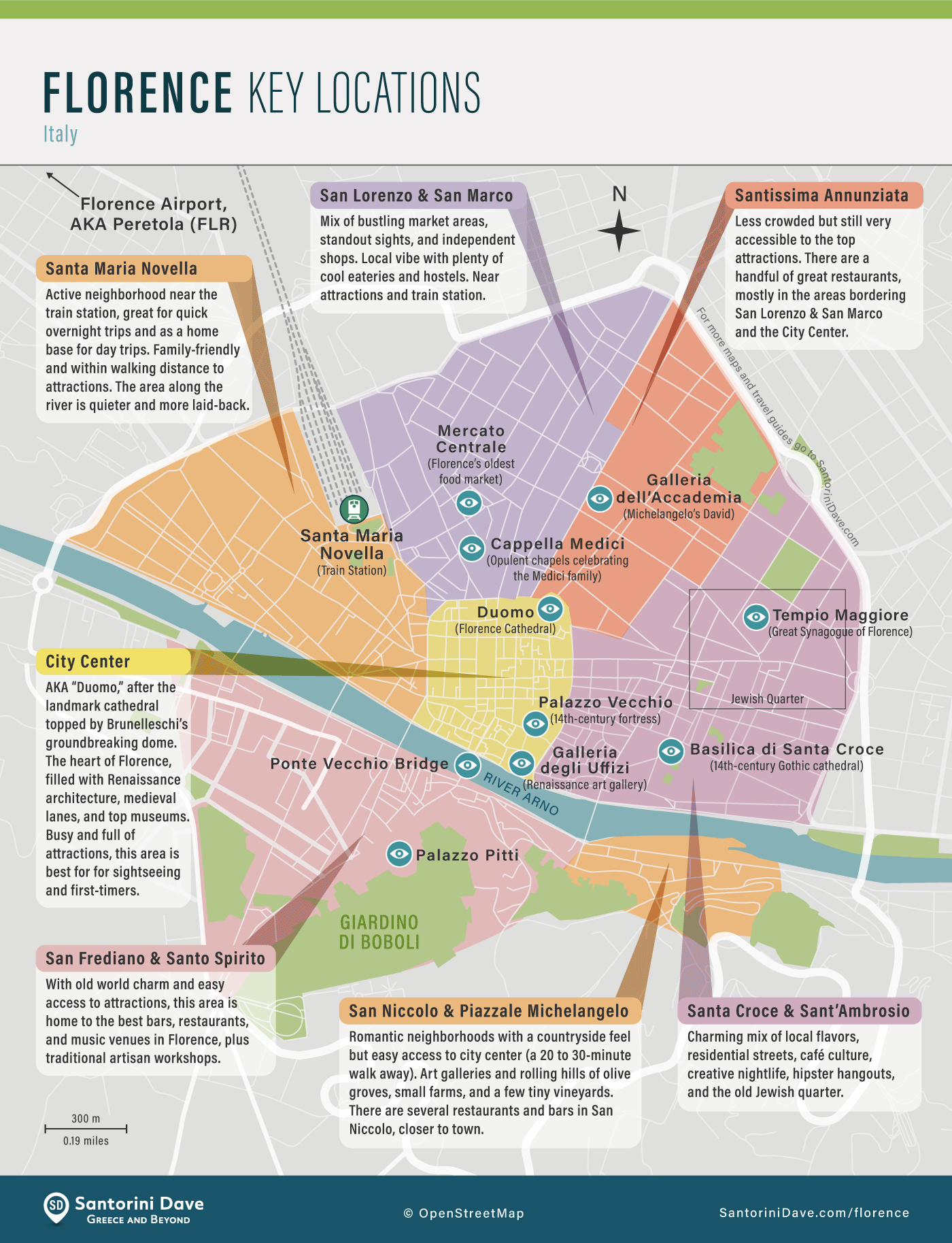
What are the best day trips from Florence?
Florence ‘s central location makes it an ideal home base for exploring nearby cities. There are organized tours and direct trains running all day from Florence to fantastic nearby cities, villages, and vineyards. The best day trips from Florence include the Chianti wine region, San Gimignano (known for its 14 medieval towers), Siena (Florence’s historic rival, beautiful duomo and museums), Fiesole (Etruscan and Roman ruins), Pisa (leaning tower and stunning architecture), Lucca (medieval walled city with towers and cathedrals), and Arezzo (medieval, Renaissance, and ancient Roman sites).
Vineyards and olive groves in the Chianti wine region just outside of Florence.
What currency is used in Florence?
Italy is part of the European Union, and the currency used in Florence is the euro (€). Most restaurants, museums, and attractions in Florence accept credit cards, but it is a good idea to have some cash on hand for small purchases like bus tickets, small souvenirs, a quick lunch or scoop of gelato, and taxi fare. ATMs are easy to find throughout the city.
Gustapizza is the best pizza restaurant in Florence. Many gelaterias, cafés, and casual restaurants like this one accept cash only, so be sure to keep a few euro on hand.
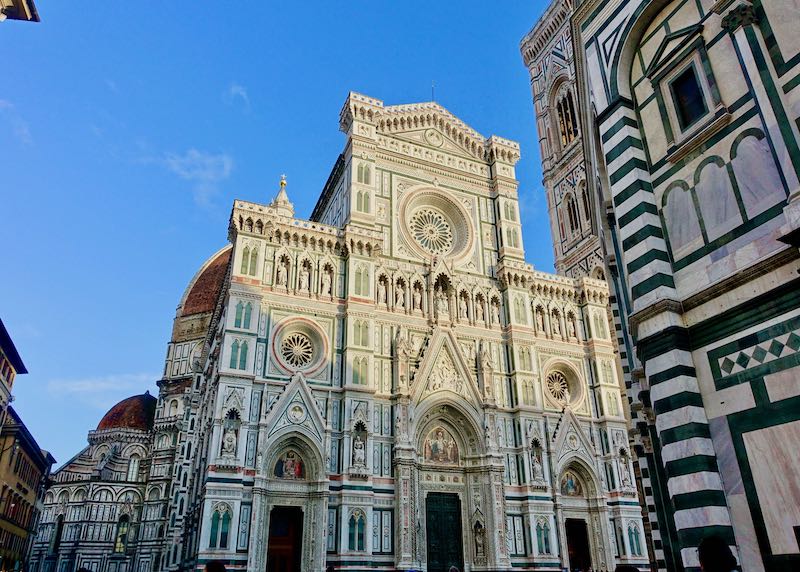

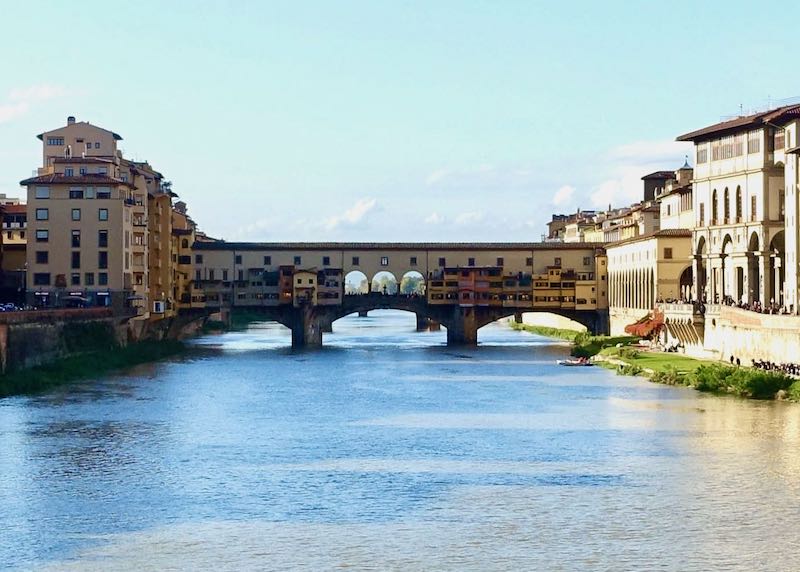

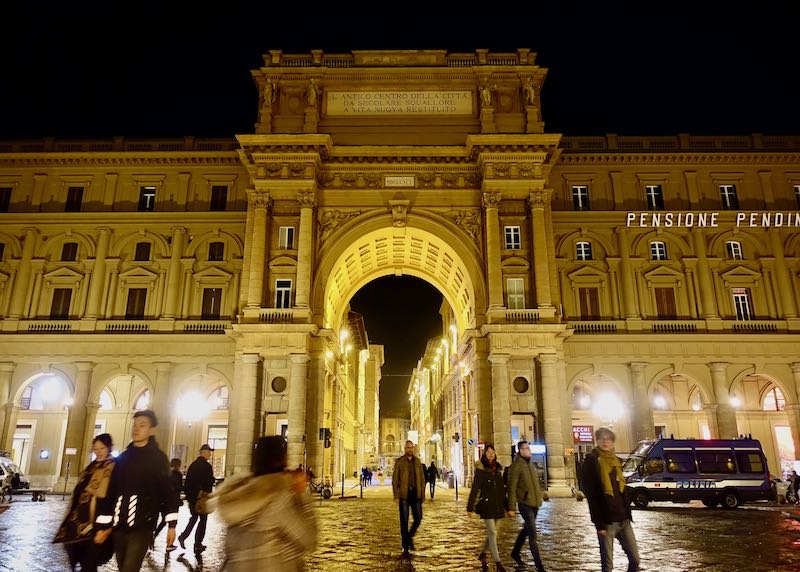
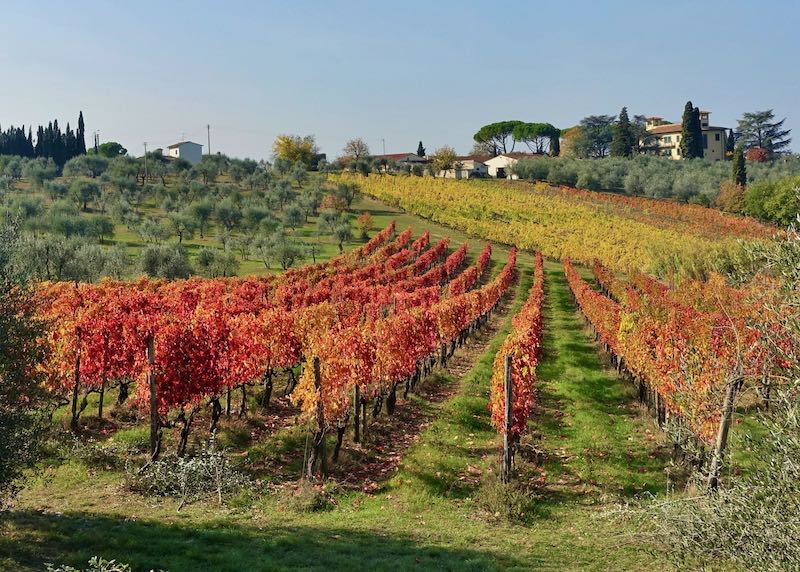
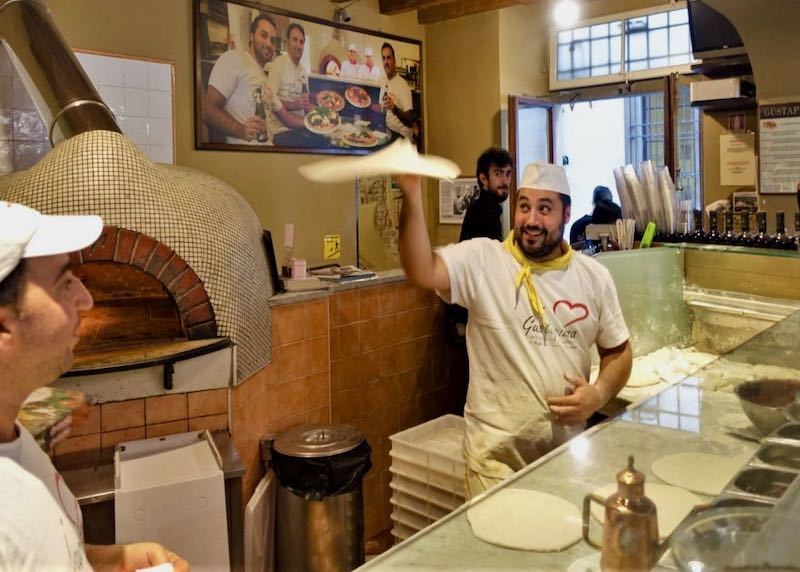
About Santorini Dave